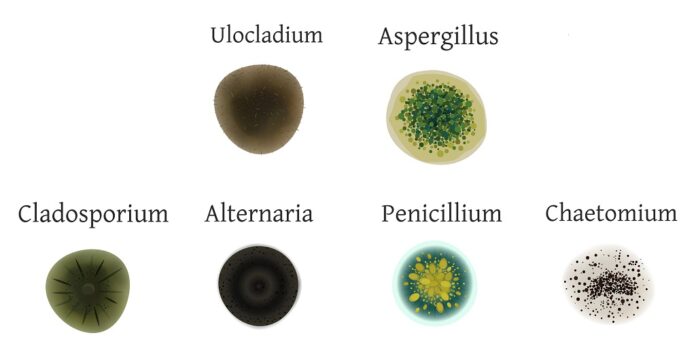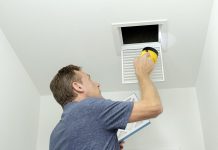Dark and moist spaces are ideal for mold growth. Not only is mold unsightly, it can also damage your home and cause health problems.
Let’s check the types of mold, their symptoms and how to get rid of them.
What is mold?
Mold is a type of fungi that reproduces by releasing spores into the air. When these spores land on a moist surface, they can start to grow. Molds can grow on almost any type of surface, including wood, paper, carpet, and food.
Exposure to mold can cause a number of health problems, such as allergic reactions, headaches, and respiratory problems. People with lung infections or other respiratory conditions are especially at risk for complications from mold exposure.
If you think you may have a mold problem in your home, there are a few things you can do to check for it. Look for visible signs of mold, such as black or greenish-black mold stains. You may also be able to smell mold, which can have a earthy or musty odor.
Molds can cause a variety of health problems, so it’s important to be aware of the symptoms of mold exposure. These can include coughing, sneezing, watery eyes, and difficulty breathing. If you experience any of these symptoms after being in an area with mold, be sure to see your doctor for an evaluation.
You can also take steps to prevent mold growth in your home by controlling moisture levels.
Common Type of Molds
There are many different types of mold, and most of them are common molds that are present in our house. They can all cause different health problems. Some of the most common types of mold include:
Aspergillus:
This type of mold is often found in soil and on decaying plants. It can cause allergic reactions, including asthma attacks, and respiratory infections. Aspergillus is a black mold that is commonly white or yellow in color. The spores of Aspergillus fumigatus are found everywhere in the air, and this species is considered pathogenic. This toxic mold can cause lethal infections in people with compromised immune systems.
Cladosporium:
This type of mold is often found on dead leaves and wood. It can cause skin irritation, hay fever, and other allergic reactions. Cladosporium has brown to blackish-brown or gray-green mold. A colony of Cladosporium on agar has a very dark greenish-black or blue-black reverse side.
Penicillium:
This type of mold is often found on food, such as cheese and bread. It can cause respiratory infections and allergic reactions. The blue-green color is unique and can be found in a bunch of shades, from dark green that has a blue hint to bright turquoise spores.
The problem with there being so many mold species is that differentiating toxic molds from household molds is nearly impossible for an untrained professional. If you discover mold growth in your home, you should call a professional mold removal company to inspect the area and determine if your home requires treatment.
Symptoms of mold exposure
Mold exposure can cause a variety of health problems, including:
Allergic reactions:
Mold exposure can cause allergic reactions, such as sneezing, watery eyes, and skin irritation. People with asthma or other respiratory conditions may be at risk for more severe reactions, such as difficulty breathing.
Respiratory infections:
Mold spores can cause pulmonary infections, such as bronchitis and pneumonia. These infections are more likely to occur in people with weakened immune systems.
Headaches:
Some people may experience headaches after being exposed to mold.
Mold spores are a common component of household and workplace dust; however, when mold spores are present in large quantities, they can present a health hazard to humans, potentially causing allergic reactions and respiratory problems. Some molds also produce mycotoxins that can pose serious health risks to humans and animals. It is important to be cautious all the time.
How does mold get indoors?
Mold spores are present in the air both indoors and outdoors. They can enter your home through open doors, windows, or vents, or they can be carried in on clothing or pets.
Once mold spores are inside your home, they can start to grow if the conditions are right. Mold needs moisture to grow, so it will often be found in damp areas, such as basements or bathrooms.
Mold spores grow in humid areas, like:
- Basements
- Bathrooms
- Laundry rooms
- Kitchens
- humidifiers
Ways to get rid of Molds
If you have a mold problem in your home, you’ll need to take steps to get rid of it. Mold can cause serious health problems, so it’s important to deal with the problem as soon as possible.
You can clean up small areas of mold yourself, but you may need to call in a professional if the problem is large or severe. Professional mold remediation companies will have the experience and equipment necessary to safely and effectively remove mold from your home.
There are a few things you can do to prevent mold growth in your home, such as:
Controlling moisture levels:
Mold thrives in moist environments, so it’s important to keep your home dry. Use a dehumidifier to remove excess moisture from the air, and fix any leaks or other sources of water.
Ventilating:
Make sure your home is well-ventilated to allow air to circulate. Use exhaust fans in the kitchen and bathroom, and open doors and windows when weather permits.
Cleaning:
Regularly clean your home, especially areas that are prone to mold, such as the kitchen and bathroom. Wipe down surfaces, vacuum carpets, and mop floors. It’s easy for a person with allergies to be treated quickly with the help of household disinfecting products. When using these items, make sure adequate breathable ventilation and wear clothing and gloves to avoid scratches, eye splints and other damage.
If you have a mold problem in your home, taking these steps can help to prevent it from coming back.
Takeaway
It is hard to get rid of Molds once it starts to grow. Molds can cause serious health problems and can damage your home, so it’s important to take steps to prevent it from growing in your home. Call a professional if the problem is large or severe. There are mold removal companies that will have the experience and equipment necessary to safely and effectively remove mold from your home. Ask for help. It’s better to be safe than sorry.
































